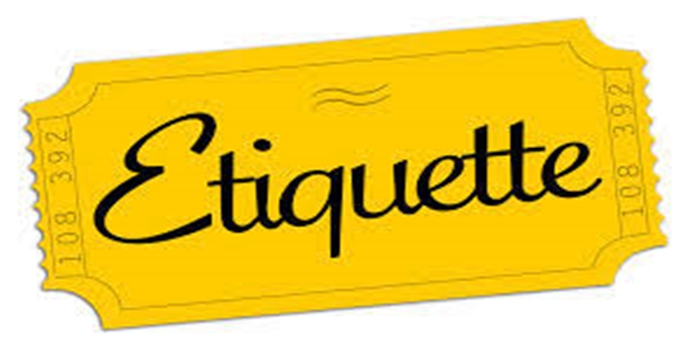In this article, we discussed the meaning of etiquette, the examples, the types, furthermore we also talked about the principles and rules.
Definition
Etiquette is a set of guidelines for expected social behavior. We share a world with other people and etiquette assumes a commitment to personal responsibility and civility.
Etiquette the customs or rules governing behavior regarded as correct or acceptable in social or official life. a conventional but unwritten code of practice followed by members of any of certain professions or groups.
The common examples of etiquette include:
Using proper greetings
Using polite phrases such as please and thank you when requesting something
Addressing appropriately for each occasion and social context.
Types of Etiquette
Social etiquette
One of the most important etiquettes is social etiquette as it informs an individual about the norms and behavior that society considers acceptable
- Meeting etiquette
This type informs individuals about the styles one should give preference to while attending meetings, seminars, and events.
- Wedding etiquette
Yes, there are in place that inform individuals that one should not be late, should behave sensibly, and do not drink too much at weddings.
- Corporate etiquette
This informs individuals about how an individual should behave at his workplace and maintain dignity.
- Bathroom etiquette
This refers to the rules that an individual should follow if he is using public or office toilets.
- Business
This acts as a guiding force to the professionals and helps them in conducting business deals in an ethical and effective manner
- Eating etiquette
This type informs individuals about the rules and regulations regarding their eating habits.
Do not speak when the mouth is full, thank the person serving your food, do not leave the table until everyone has finished eating, etc.
- Telephone etiquette
This type informs individuals about how they should behave on the telephone. How to interact with others, not putting someone on hold for a long time, greeting the other person, and keeping your tone and pitch at the perfect level are basic telephone one should always follow.
Etiquette rules are a set of guidelines for respectful and considerate behavior. They can help to prevent misunderstandings and conflicts, and create a sense of professionalism.
Some examples of rules are:
Be on time: Being punctual shows respect and professionalism. It’s especially important in business settings, where missing a deadline can affect the whole team.
Dress appropriately: Dress code can demonstrate employee equality. If there’s no dress code, you can try to dress smartly in traditional business colors like black, blue, grey, or white.
Be respectful: Show respect by acknowledging others’ qualities and boundaries, and by giving them your full attention.
Be considerate: Understand others’ needs and rights, and prioritize their feelings.
Be honest: Act with sincerity and integrity.
Use polite phrases: Use phrases like “please” and “thank you” when making requests.
Use your turn signal: Let other drivers know when you intend to merge or turn.
The main principles of etiquette are respect, consideration, and honesty.
Respect
Acknowledge others’ qualities and boundaries
Be inclusive and open-minded
Be gracious and appreciative
Dress appropriately for the occasion
Give your full attention to others
Put others in the spotlight
Value others’ ideas and beliefs
Be punctual
Be polite
Be well groomed
Make eye contact
Mind your posture
Practice good table manners
Respect personal space
Conclusion
Etiquette is a code of conduct reflecting social norms and expectations about how to behave in social situations. Different types include social , which is the polite code of conduct in social settings, and netiquette, which is online network . Other types include telephone, dining, bathroom, business, and corporate it . The rules and principles are based on respect, consideration, and honesty.


